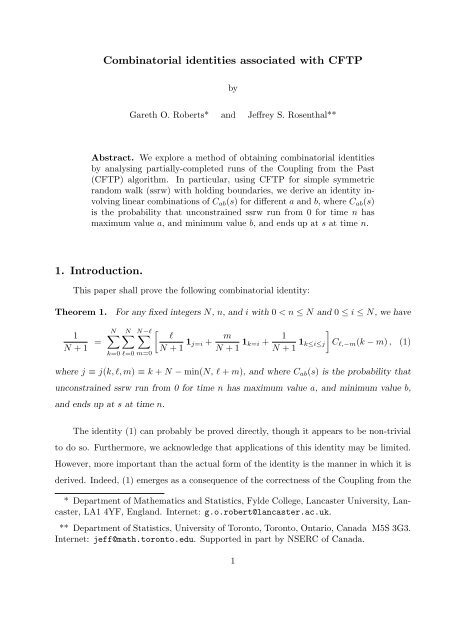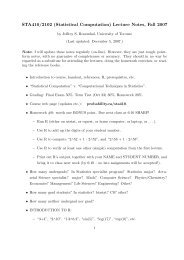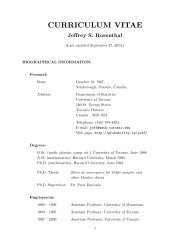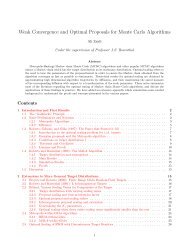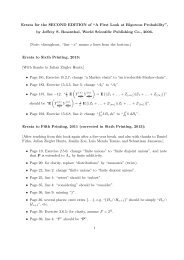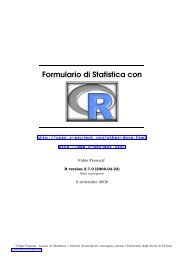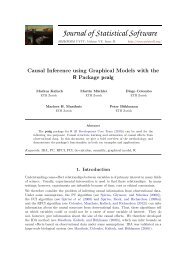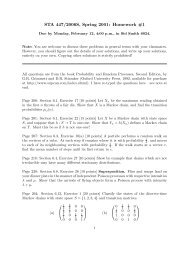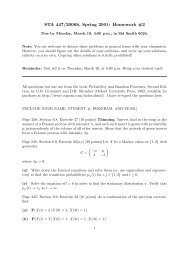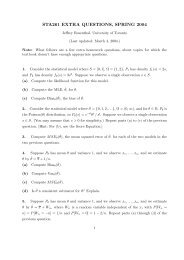this research paper - probability.ca
this research paper - probability.ca
this research paper - probability.ca
You also want an ePaper? Increase the reach of your titles
YUMPU automatically turns print PDFs into web optimized ePapers that Google loves.
Combinatorial identities associated with CFTP<br />
by<br />
Gareth O. Roberts* and Jeffrey S. Rosenthal**<br />
Abstract. We explore a method of obtaining combinatorial identities<br />
by analysing partially-completed runs of the Coupling from the Past<br />
(CFTP) algorithm. In particular, using CFTP for simple symmetric<br />
random walk (ssrw) with holding boundaries, we derive an identity involving<br />
linear combinations of C ab (s) for different a and b, where C ab (s)<br />
is the <strong>probability</strong> that unconstrained ssrw run from 0 for time n has<br />
maximum value a, and minimum value b, and ends up at s at time n.<br />
1. Introduction.<br />
This <strong>paper</strong> shall prove the following combinatorial identity:<br />
Theorem 1.<br />
1<br />
N + 1 =<br />
N ∑<br />
For any fixed integers N, n, and i with 0 < n ≤ N and 0 ≤ i ≤ N, we have<br />
N∑<br />
N−l<br />
∑<br />
k=0 l=0 m=0<br />
[<br />
l<br />
N + 1 1 j=i +<br />
m<br />
N + 1 1 k=i + 1 ]<br />
N + 1 1 k≤i≤j C l,−m (k − m) , (1)<br />
where j ≡ j(k, l, m) ≡ k + N − min(N, l + m), and where C ab (s) is the <strong>probability</strong> that<br />
unconstrained ssrw run from 0 for time n has maximum value a, and minimum value b,<br />
and ends up at s at time n.<br />
The identity (1) <strong>ca</strong>n probably be proved directly, though it appears to be non-trivial<br />
to do so. Furthermore, we acknowledge that appli<strong>ca</strong>tions of <strong>this</strong> identity may be limited.<br />
However, more important than the actual form of the identity is the manner in which it is<br />
derived. Indeed, (1) emerges as a consequence of the correctness of the Coupling from the<br />
* Department of Mathematics and Statistics, Fylde College, Lan<strong>ca</strong>ster University, Lan<strong>ca</strong>ster,<br />
LA1 4YF, England. Internet: g.o.robert@lan<strong>ca</strong>ster.ac.uk.<br />
** Department of Statistics, University of Toronto, Toronto, Ontario, Canada M5S 3G3.<br />
Internet: jeff@math.toronto.edu. Supported in part by NSERC of Canada.<br />
1
Past (CFTP) algorithm for a very simple Markov chain – the <strong>ca</strong>se of constrained simple<br />
symmetric random walk on {0, 1, . . . , N}.<br />
Since CFTP <strong>ca</strong>n be applied to essentially any ergodic Markov chain, it appears that<br />
similar (though more compli<strong>ca</strong>ted) methods could be used to derive other combinatorial<br />
identities, using other Markov chains in other settings (e.g. for the Ising model, as in Propp<br />
and Wilson, 1996).<br />
We explain the CFTP algorithm in Section 2. In Section 3, we explain how CFTP<br />
gives rise to combinatorial identities. We derive the identity (1) in Sections 4 and 5.<br />
Further remarks about the quantities C ab (j), and how to compute them, are presented in<br />
Section 6.<br />
2. Coupling from the Past (CFTP).<br />
Markov chain Monte Carlo (MCMC) algorithms are an extremely popular tool in<br />
statistics to approximately sample from a <strong>probability</strong> distribution π(·), by designing a<br />
Markov chain P (x, ·) such that π is stationary for P (see e.g. Smith and Roberts, 1993;<br />
Tierney, 1994; Gilks, Richardson, and Spiegelhalter, 1996).<br />
More recently, Propp and Wilson (1996) have developed an algorithm <strong>ca</strong>lled Coupling<br />
from the Past (CFTP), which makes use of the Markov chain P in a novel way to sample<br />
from π exactly. This has led to an explosion of <strong>research</strong> in <strong>this</strong> area; see e.g. Thönnes<br />
(2000) and the multitude of <strong>paper</strong>s described in Wilson (1998).<br />
To define CFTP, let us assume that we have an ergodic Markov chain {X n } n∈Z with<br />
transition kernel P (x, ·) on a state space X , and a <strong>probability</strong> measure π on X , such that<br />
π is stationary for P (i.e. (πP )(dy) ≡ ∫ π(dx) P (x, dy) = π(dy)). Let us further assume<br />
X<br />
that we have defined the Markov chain as a stochastic recursive sequence, so there is a<br />
function φ : X × R → X and an i.i.d. sequence of random variables {U n } n∈Z , such that<br />
we always have X n+1 = φ(X n , U n ). (It is not strictly necessary to use stochastic recursive<br />
sequences to define CFTP, see e.g. Murdoch and Rosenthal, 2000. On the other hand, it is<br />
easiest, and most common, to define CFTP in <strong>this</strong> way. Furthermore, the use of stochastic<br />
recursive sequences involves essentially no loss of generality, cf. Borovkov and Foss, 1992.)<br />
CFTP involves considering negative times n, rather than positive times. Specifi<strong>ca</strong>lly,<br />
2
let<br />
φ (n) (x; u −n , . . . , u −1 ) = φ(φ(φ(. . . φ(x, u −n ), u −n+1 ), u −n+2 ), . . .), u −1 ) . (2)<br />
Then CFTP proceeds by considering various increasing choices of T > 0, in the search for<br />
a value T > 0 such that<br />
φ (T ) (x; U −T , . . . , U −1 ) does not depend on x ∈ X , (3)<br />
i.e. such that the chain has coalesced in the time interval from time −T to time 0.<br />
Once such a T has been found, the resulting value<br />
W ≡ φ (T ) (x; U −T , . . . , U −1 )<br />
(which does not depend on x) is the output of the algorithm. Note in particular that,<br />
be<strong>ca</strong>use of the backward composition implicit in (2), W = φ (n) (y; U −n , . . . , U −1 ) for any<br />
n ≥ T and any y ∈ X . In particular, letting n → ∞, it follows by ergodicity that W ∼ π(·).<br />
(See Propp and Wilson, 1996, for a formal proof of <strong>this</strong>.)<br />
Note that the values {U n } should be thought of as being fixed in advance, even though<br />
of course they are only computed as needed. In particular, crucially, all previously-used<br />
values of {U n } must be used again, unchanged, as T is increased.<br />
In the special <strong>ca</strong>se in which φ is monotone, meaning that there is an ordering ≼<br />
on X such that φ(x, u) ≼ φ(y, u) whenever x ≼ y (which implies that P is stochasti<strong>ca</strong>lly<br />
monotone), and there are maximal and minimal elements x max , x min ∈ X , then to check (3)<br />
it suffices to check that<br />
φ (T ) (x min ; U −T , . . . , U −1 ) = φ (T ) (x max ; U −T , . . . , U −1 ) . (4)<br />
3
3. Identities arising from CFTP.<br />
As mentioned above, CFTP does a search for a value of T satisfying (3), by checking<br />
increasing values of T (often simply doubling the value of T each time) until (3) is satisfied.<br />
Suppose in particular that some fixed value of T has been tried, so that the values<br />
U −T , . . . , U −1 have been generated, and the paths {φ (n) (x, ; U −n , . . . , U −1 )} 1≤n≤T<br />
have<br />
been computed (and perhaps even displayed), though coalescence may have occured by<br />
then. Conditional on the values U −T , . . . , U −1 , the output value W will have some conditional<br />
distribution. Since overall W ∼ π(·), we must have from the Law of Total Probability<br />
that<br />
∫<br />
∫<br />
. . .<br />
P(U −1 ∈ du −1 , . . . , U −T ∈ du −T ) P(W ∈ A | U −1 = u −1 , . . . , U −T = u −T ) = π(A) .<br />
Now, P(W ∈ A | U −1 = u −1 , . . . , U −T = u −T ) could be computed as<br />
P(W ∈ A | U −1 = u −1 , . . . , U −T = u −T ) = P(φ (T ) (X −T ; U −1 , . . . , U −T ) ∈ A) , (5)<br />
except that X −T is unknown. On the other hand, given the values of {U n }, suppose we<br />
choose S > T large enough that φ (S−T ) (x; U −S , . . . , U −S+T −1 ) does not depend on x ∈ X ,<br />
i.e. that coalescence occurs during the time interval from time −S to time −S + T . Let<br />
Z = φ (S−T ) (x; U −S , . . . , U −S+T −1 ) (which does not depend on x). Then, by the validity<br />
of CFTP, we see that Z ∼ π(·). Also, by construction,<br />
φ (S) (x; u −S , . . . , u −1 ) = φ (T ) (φ (S−T ) (x; u −S , . . . , u −T −1 ); u −T , . . . , u −1 )<br />
= φ (T ) (Z; u −T , . . . , u −1 ) .<br />
This suggests that in (5), we <strong>ca</strong>n assume that X −T = Z ∼ π(·). The following result<br />
confirms <strong>this</strong>.<br />
Theorem 2. Consider any CFTP algorithm as described above. Then for any T ∈ N,<br />
∫<br />
∫<br />
. . .<br />
P(U −1 ∈ du −1 , . . . , U −T ∈ du −T ) π{x ∈ X ; φ (T ) (x; u −1 , . . . , u −T ) ∈ A} = π(A) .<br />
(6)<br />
4
Proof. This follows immediately from the stationarity of π, since all says is that if we<br />
start a Markov chain in stationarity at time −T , then it will still be in stationarity at<br />
time 0.<br />
Remark. The proof of Theorem 2 shows that the result does not really depend on CFTP<br />
at all, just on the stationarity of π(·) for the Markov chain. However, it was CFTP that<br />
led us to consider these identities, and provides the proper context for them.<br />
In principle, (6) gives a separate identity for every single Markov chain. The difficulty<br />
lies in interpreting (6) in a way that is meaningful and insightful. To do <strong>this</strong>, it is necessary<br />
to consider particular Markov chains.<br />
4. The <strong>ca</strong>se of ssrw on {0, . . . , N}.<br />
Consider simple symmetric random walk (ssrw) on X = {0, . . . , N}, with holding<br />
boundaries. That is, let {U n } n∈Z be i.i.d., with P(U n = +1) = P(U n = −1) = 1 2 , and<br />
define a Markov chain by<br />
X n+1 = max [ 0, min[N, X n + U n ] ] . (7)<br />
As a stochastic recursive sequence, we <strong>ca</strong>n write <strong>this</strong> as X n+1 = φ(X n , U n ), where<br />
φ(x, u) = max [ 0, min[N, x + u] ] .<br />
This Markov chain has as its stationarity distribution the uniform distribution on X ,<br />
so that π(x) = 1/(N + 1) for x ∈ X . (Indeed, the chain is reversible with respect to π(·),<br />
and in fact it may be regarded as a Metropolis algorithm for π(·) with proposal given by<br />
unconstrained ssrw.) Hence, we <strong>ca</strong>n run CFTP for <strong>this</strong> Markov chain, to output a value<br />
W ∼ π(·). See Rosenthal (1998) for an interactive display of CFTP for <strong>this</strong> Markov chain,<br />
which illustrates the status of the algorithm after a particular choice of T has been tried<br />
but coalescence has not been achieved.<br />
Note that <strong>this</strong> chain is indeed monotone, with maximal and minimal values x max = N<br />
and x min = 0. Hence, to check for coalescence we need only check (4). Thus, we consider<br />
just the “bottom process” starting at 0, and the “top process” starting at N.<br />
5
We wish to specialise the general identity (6) to <strong>this</strong> particular <strong>ca</strong>se. To do so, we<br />
proceed as follows.<br />
We first define a “hold” for the top or bottom process to be a time such that the chain<br />
remains in the same state. That is, for fixed N, we let<br />
H top<br />
n = # { m; 1 ≤ m ≤ n; φ (n−m) (N; U −n , . . . , U −n+m ) = φ (n−m+1) (N; U −n , . . . , U −n+m−1 ) } ,<br />
and<br />
H bot<br />
n = # { m; 1 ≤ m ≤ n; φ (n−m) (0; U −n , . . . , U −n+m ) = φ (n−m+1) (0; U −n , . . . , U −n+m−1 ) } .<br />
Let R N,n,l,m,k be the <strong>probability</strong> that the Markov chain given by (7), when run for a<br />
time n, has all of the following properties: (a) the bottom process ends up at k ∈ X ; (b)<br />
the top process has l holds; and (c) the bottom process has m holds. It necessarily follows<br />
from <strong>this</strong> that (d) the top process ends up at j = j(k, l, m) = k + N − min(N, l + m).<br />
In symbols, if we fix N throughout, then we <strong>ca</strong>n write <strong>this</strong> as<br />
R N,n,l,m,k<br />
= P(φ (n) (0, U −n , . . . , U −1 ) = k, H top<br />
n<br />
= l, H bot<br />
n = m) .<br />
We have the following.<br />
Lemma 3. Consider a partial run of CFTP for ssrw, from time −n to time 0, as above.<br />
Let j ≡ j(k, l, m) ≡ k + N − min(N, l + m). Then if l + m < N (so that j < k), then<br />
and for j < i < k,<br />
P (W = k | φ (n) (0, U −n , . . . , U −1 ) = k, H top<br />
n<br />
P (W = j | φ (n) (0, U −n , . . . , U −1 ) = k, H top<br />
n<br />
= l, H bot<br />
n = m) = l + 1<br />
N + 1 ,<br />
= l, H bot<br />
n = m) = m + 1<br />
N + 1 ,<br />
P (W = i | φ (n) (0, U −n , . . . , U −1 ) = k, H top<br />
n<br />
= l, H bot<br />
n = m) =<br />
1<br />
N + 1 .<br />
If instead l + m = N, so that j = k, then<br />
P (W = k | φ (n) (0, U −n , . . . , U −1 ) = k, H top<br />
n<br />
6<br />
= l, H bot<br />
n = m) = 1 .
Proof. As in the proof of Theorem 2, we may assume (either by extending the CFTP<br />
construction back far enough, or by simply using stationarity of π) that the run {X t } is<br />
already in stationarity at time −n.<br />
Now, from time −n to 0, assuming the processes have not yet coalesced, then every<br />
time the top process holds, the process {X t } moves one unit closer to the top process.<br />
Similarly, every time the bottom process holds, the process {X t } moves one unit closer to<br />
the bottom process. It follows that X 0 = j if and only if X −n ≥ N − l, and X 0 = k if<br />
and only if X −n ≤ m. Otherwise, the values of X −n strictly between m and N − l are in<br />
a one-one correspondence with the values of X 0 strictly between k and j.<br />
Hence, if l + m < N so that j < k, then<br />
and<br />
P (W = k | φ (n) (0, U −n , . . . , U −1 ) = k, H top<br />
n<br />
= l, H bot<br />
n = m) = P (X −n ≤ m) ,<br />
P (W = j | φ (n) (0, U −n , . . . , U −1 ) = k, H top<br />
n<br />
while for j < i < k,<br />
= l, H bot<br />
n = m) = P (X −n ≥ N − l) ,<br />
P (W = i | φ (n) (0, U −n , . . . , U −1 ) = k, H top<br />
n<br />
Since X −n ∼ π(·), the result for the <strong>ca</strong>se j < k follows.<br />
On the other hand, if l + m = N so that j = k, then<br />
= l, H bot<br />
n = m) = P (X −n = m − k + i) .<br />
P (W = k | φ (n) (0, U −n , . . . , U −1 ) = k, H top<br />
n<br />
thus establishing the result in the <strong>ca</strong>se l + m = N as well.<br />
= l, H bot<br />
n = m) = P (X −n ∈ X ) = 1 ,<br />
Using <strong>this</strong> lemma and the definition of R N,n,l,m,k , we see that Theorem 2 <strong>ca</strong>n now be<br />
written as follows. (For the <strong>ca</strong>se l + m = N, we use the observation that if i = j = k, then<br />
l<br />
N+1 1 j=i + m<br />
N+1 1 k=i + 1<br />
N+1 1 k≤i≤j = 1.)<br />
7
Proposition 4.<br />
For fixed integers N, n, and i, with 0 < n ≤ N and 0 ≤ i ≤ N, letting<br />
j = j(k, l, m) = k + N − min(N, l + m), we have the identity<br />
1<br />
N + 1 =<br />
N ∑<br />
k=0<br />
∑<br />
l,m≥0<br />
m+l≤n<br />
[<br />
l<br />
N + 1 1 j=i +<br />
m<br />
N + 1 1 k=i + 1 ]<br />
N + 1 1 k≤i≤j R N,n,l,m,k .<br />
5. Interpreting the quantities R N,n,l,m,k .<br />
To clarify the result of Proposition 4, we wish to better interpret the quantities<br />
R N,n,l,m,k . Fix N, n ∈ N throughout. We first note the following.<br />
Proposition 5. If l + m ≤ N, then R N,n,l,m,k is equal to the <strong>probability</strong> that unconstrained<br />
ssrw starting at 0 and run for time n, has maximum value l, minimum value −m,<br />
and ends up at k − m. In symbols,<br />
R N,n,l,m,k = C l,−m (k − m) ,<br />
where<br />
[<br />
C ab (s) = P max Z t = a,<br />
0≤t≤n<br />
]<br />
min Z t = b, Z n = s ,<br />
0≤t≤n<br />
where {Z t } is unconstrained ssrw started at 0 and run for time n.<br />
Proof. Consider running CFTP as described above, using random variables U −n , . . . , U −1 .<br />
Let Z 0 = 0, and Z t = U −n + . . . + U −n+t−1 for 0 < t ≤ n. Then {Z t } is indeed equal to<br />
an unconstrained ssrw started at 0 and run for time n. However, it has now been coupled<br />
with the CFTP algorithm under consideration, and we shall make use of <strong>this</strong> fact.<br />
Now, suppose that for the CFTP algorithm, the event whose <strong>probability</strong> is R N,n,l,m,k<br />
has indeed occurred. That is, suppose that the bottom process of CFTP ends up at k, the<br />
top process has l holds, and the bottom process has m holds. We wish to see what effect<br />
these suppositions have on the unconstrained process {Z t }.<br />
Let −s be the time just after the last hold of the bottom process of the CFTP algorithm.<br />
Then the corresponding value of the {Z t } process, namely Z n−s , must be equal to<br />
−m. Furthermore, we will then have Z t ≥ −m for all t ≥ n − s. It follows that we will<br />
have min 0≤t≤n Z t = −m. Similarly, we will have max 0≤t≤n Z t = −m.<br />
8
Finally, the value of Z n must be equal to the value of the bottom process in the<br />
CFTP algorithm, minus the number of times the bottom process held at 0 (so that it<br />
didn’t decrease, even though {Z t } did). Hence, we must have Z n = k − m.<br />
Conversely, it is easily checked that if min 0≤t≤n Z t = −m, and max 0≤t≤n Z t = −m,<br />
and Z n = k − m, then it must be that the bottom process of CFTP ends up at k, the top<br />
process has l holds, and the bottom process has m holds.<br />
We conclude that<br />
R N,n,l,m,k<br />
= P( min<br />
0≤t≤n Z t = −m ,<br />
max Z t = −m , Z n = k − m) .<br />
0≤t≤n<br />
This gives the result.<br />
Combining Proposition 5 with Proposition 4, we immediately obtain Theorem 1.<br />
Remark.<br />
If l + m > N, then it is possible that the bottom process will actually reach<br />
the top value of N, and then hold at the top value. This implies that the final value of<br />
the corresponding unconstrained ssrw will no longer be just a function of k, l, m, which<br />
<strong>ca</strong>uses additional compli<strong>ca</strong>tions. It is possible to overcome these compli<strong>ca</strong>tions, however<br />
to do so is somewhat messy and not particularly useful. Hence, in the above proposition,<br />
we restrict to the <strong>ca</strong>se l + m ≤ N. In Theorem 1, we restrict to the <strong>ca</strong>se n ≤ N, precisely<br />
so that these additional compli<strong>ca</strong>tions do not arise.<br />
6. Computing the quantities C ab (s).<br />
In order to verify the result of Theorem 1 numeri<strong>ca</strong>lly (say), it is necessary to know<br />
how to compute the quantities C ab (s). The reflection principle for ssrw is of some help<br />
here. However, since the events corresponding to C ab (s) specify both a maximum value<br />
and a minimum value, it seems that the best we <strong>ca</strong>n do is compute C ab (s) in terms of a<br />
sum of O(n) terms. We present that here.<br />
To begin, let<br />
Q n (x) =<br />
⎧<br />
⎪⎨<br />
⎪⎩<br />
( ) n<br />
2 −n n+x<br />
, − n ≤ x ≤ n, x + n even<br />
2<br />
0 , otherwise<br />
9
e the <strong>probability</strong> that unconstrained ssrw on the set of all integers, starting from 0, is at<br />
the point x at time n.<br />
Now, for any integers x 1 , x 2 , . . . , x r , j, let A x1 x 2 ...x r<br />
(j) be the <strong>probability</strong> that unconstrained<br />
ssrw, starting from 0 and run for time n, hits in turn the values x 1 , x 2 , . . . , x r ,<br />
and then ends up at j at time n. Also, say a sequence x 1 , x 2 , . . . , x r is sign alternating if<br />
(x q − x q−1 )(x q+1 − x q ) ≤ 0 for 2 ≤ q ≤ r − 1.<br />
Lemma 6. If the sequence x 1 , x 2 , . . . , x r , j is sign-alternating, then<br />
A x1 x 2 ...x r<br />
(j) = Q n (|x 1 | + |x 2 − x 1 | + . . . + |x r − x r−1 | + |j − x r |) .<br />
Proof. Just use the reflection principle for ssrw, r times (cf. pp. 72, 96 of Feller, 1968).<br />
Now let B ab (j) be the <strong>probability</strong> that unconstrained ssrw hits run from time 0 to n,<br />
hits both a and b, and furthermore ends up at j at time n.<br />
Lemma 7. We always have B 00 (j) = 0. Otherwise, for (a, b) ≠ (0, 0) and ab ≤ 0,<br />
B ab (j) = [A ab (j) − A aba (j) + A abab (j) − A ababa (j) + . . .]<br />
+ [A ba (j) − A bab (j) + A baba (j) − A babab (j) + . . .] .<br />
(Since A x1 x 2 ...x r<br />
(j) = 0 whenever |x 1 | + |x 2 − x 1 | + . . . + |x r − x r−1 | > n, the above sums<br />
each terminate after at most n/|b − a| terms.)<br />
Proof.<br />
By the inclusion-exclusion principle, the <strong>probability</strong> that we first hit b, and then<br />
hit a, finally ending up at j, is equal to<br />
A ab (j) − A bab (j) + A abab (j) − A babab (j) + . . . .<br />
Similarly, the <strong>probability</strong> that we first hit a, and then hit b, finally ending up at j, is equal<br />
to the same sum but with a and b reversed. Adding these two sums, we obtain the formula<br />
for B ab (j) as claimed.<br />
10
Remark.<br />
Note that we <strong>ca</strong>nnot compute B ab (j) in simple closed form, as<br />
[A ab (j) − A bab (j)] + [A ba (j) − A aba (j)] .<br />
The problem with <strong>this</strong> is that paths of the form abab would end up getting added and<br />
subtracted equally often, and therefore counted a total of zero times, rather than one time<br />
as desired.<br />
Now re<strong>ca</strong>ll that C ab (j) is the <strong>probability</strong> that unconstrained ssrw has maximum value<br />
a, and minimum value b, and ends up at j at time n.<br />
Lemma 8. For a ≥ 0 ≥ b,<br />
C ab (j) = B ab (j) − B a+1,b (j) − B a,b−1 (j) + B a+1,b−1 (j) .<br />
Proof. B ab (j) is the <strong>probability</strong> that the max is at least a and the min is at most b<br />
(and we end up at j). The formula then follows from the basic <strong>probability</strong> result that<br />
P(A 1 ∩ A C 2 ∩ A C 3 ) = P(A 1 ) − P(A 1 ∩ A 2 ) − P(A 1 ∩ A 3 ) + P(A 1 ∩ A 2 ∩ A 3 ), where<br />
A 1 = {max ≥ a , min ≤ b}, A 2 = {max ≥ a + 1}, A 3 = {min ≤ b − 1}.<br />
The above three lemmas together provide a fully computable formula for R N,n,l,m,j ,<br />
whenever l + m ≤ N. This allows us to numeri<strong>ca</strong>lly verify the identity (1), for any appropriate<br />
choices of N, n, and i. Such verifi<strong>ca</strong>tion has been done in the C program combin.c,<br />
freely available at http://markov.utstat.toronto.edu/jeff/comp/combin.c<br />
The three lemmas also allow the possibility of analyti<strong>ca</strong>lly expanding the identity of<br />
Theorem 1 further, in an effort to simplify or better understand it. However, it is not clear<br />
that such an expanded version provides any helpful new insights, so we do not pursue it<br />
here.<br />
11
REFERENCES<br />
A.A. Borovkov and S.G. Foss (1992), Stochasti<strong>ca</strong>lly recursive sequences and their<br />
generalizations. Siberian. Adv. Math. 2, 16–81.<br />
S.P. Brooks (1998), Markov Chain Monte Carlo Method and its Appli<strong>ca</strong>tion. The<br />
Statistician 47, 69–100.<br />
W. Feller (1968), An Introduction to Probability Theory and its Appli<strong>ca</strong>tions, Volume<br />
I (3 rd ed.). Wiley, New York.<br />
W.R. Gilks, S. Richardson, and D.J. Spiegelhalter, eds. (1996), Markov chain Monte<br />
Carlo in practice. Chapman and Hall, London.<br />
D.J. Murdoch and P.J. Green (1998), Exact sampling from a continuous state space.<br />
S<strong>ca</strong>ndinavian Journal of Statistics 25(3), 483–502.<br />
D.J. Murdoch and J.S. Rosenthal (2000), “Efficient use of exact samples”. Statistics<br />
and Computing 10, 237–243.<br />
J.G. Propp and D.B. Wilson (1996). Exact sampling with coupled Markov chains and<br />
appli<strong>ca</strong>tions to statisti<strong>ca</strong>l mechanics. Random Structures and Algorithms 9, 223–252.<br />
J.S. Rosenthal (1998). CFTP Java Applet. Available at<br />
http://markov.utstat.toronto.edu/jeff/java/cftp.html<br />
A.F.M. Smith and G.O. Roberts (1993), Bayesian computation via the Gibbs sampler<br />
and related Markov chain Monte Carlo methods (with discussion). J. Roy. Stat. Soc. Ser.<br />
B 55, 3-24.<br />
E. Thönnes (2000), A primer on perfect simulation. In Statisti<strong>ca</strong>l Physics and Spatial<br />
Statistics (K.R. Mecke and D. Stoyan, eds.), Springer Lecture Notes in Physics, volume<br />
554, 349–378.<br />
L. Tierney (1994), Markov chains for exploring posterior distributions (with discussion).<br />
Ann. Stat. 22, 1701-1762.<br />
D.B. Wilson (1998). Annotated bibliography of perfectly random sampling with Markov<br />
chains. Available at http://dimacs.rutgers.edu/∼dbwilson/exact/<br />
12


